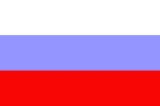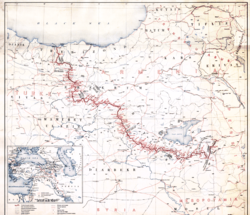
Western Armenia
Encyclopedia
Western Armenia is a term, primarily used by Armenians, to refer to Armenian-inhabited areas of the Armenian Highland
that were part of the Ottoman Empire
and now are part of the Republic of Turkey.
After the Hamidian Massacres
of 1894-1896 and the Armenian Genocide
(1915-1923) the indigenous Armenian population was either massacred, escaped to Russia or deported to the Syrian deserts. Currently, mostly Kurds and Turks live in that area, with minorities being Azerbaijanis, Laz people
and Hamshenis
.
In Armenian
Western Armenia became part of the Ottoman Empire
. Since the Russo-Turkish War, 1828-1829
, the term "Western Armenia" has referred to the Armenian
-populated historical regions of the Ottoman Empire that remained under Ottoman
rule after the eastern part
of Armenia was ceded
to the Russian Empire
.
Western (Ottoman) Armenia consisted of six vilayets (vilâyat-ı sitte) — the vilayets of Erzurum, Van, Bitlis
, Diyarbekir, Kharput, and Sivas.
 During the collapse of Ottoman Empire
During the collapse of Ottoman Empire
Western Armenia remained under Turkish
rule, and in 1894–96 and 1915 the Ottoman Empire perpetrated systematic massacres and forced deportations of Armenians resulting in the Armenian Genocide
.
During the Caucasus Campaign
of the World War I
, Russian Empire
occupied most of the Armenian-populated regions of the Ottoman Empire, where a temporary provincial government
was established in 1915–1918.
" — is considered as a key issue in the modern history of the Armenian people. The first and second congresses of Western Armenians took place in Yerevan
in 1917 and 1919. Since 2000, an organizing committee of congress of heirs of Western Armenians who survived the Armenian Genocide is active in diasporan communities.
Currently, the Republic of Armenia doesn't have any territorial claims to the Republic of Turkey, although, some political parties such as the Armenian Revolutionary Federation
, the largest Armenian party in the diaspora
, claim the area given to the Republic of Armenia (1918-1920)
by US President Woodrow Wilson
's arbitral award in 1920, also known as Wilsonian Armenia
.

Armenian Highland
The Armenian Highland is the central-most and highest of three land-locked plateaus that together form the northern sector of the Middle East...
that were part of the Ottoman Empire
Ottoman Empire
The Ottoman EmpireIt was usually referred to as the "Ottoman Empire", the "Turkish Empire", the "Ottoman Caliphate" or more commonly "Turkey" by its contemporaries...
and now are part of the Republic of Turkey.
After the Hamidian Massacres
Hamidian massacres
The Hamidian massacres , also referred to as the Armenian Massacres of 1894–1896, refers to the massacring of Armenians by the Ottoman Empire, with estimates of the dead ranging from anywhere between 80,000 to 300,000, and at least 50,000 orphans as a result...
of 1894-1896 and the Armenian Genocide
Armenian Genocide
The Armenian Genocide—also known as the Armenian Holocaust, the Armenian Massacres and, by Armenians, as the Great Crime—refers to the deliberate and systematic destruction of the Armenian population of the Ottoman Empire during and just after World War I...
(1915-1923) the indigenous Armenian population was either massacred, escaped to Russia or deported to the Syrian deserts. Currently, mostly Kurds and Turks live in that area, with minorities being Azerbaijanis, Laz people
Laz people
The Laz are an ethnic group native to the Black Sea coastal regions of Turkey and Georgia...
and Hamshenis
Hamshenis
The Hemshin Peoples or Hemshinli are a diverse group of people who in the past history or present have been affiliated with the Hemşin district in the province of Rize, Turkey. They are called as Hemshinli , Hamshenis, Homshentsi meaning resident of Hemshin in the relevant language...
.
Names
In English- Turkish Armenia is an archaic term used until 1920s
- Ottoman Armenia is an archaic term used until 1920s
In Armenian
- Արեւմտեան Հայաստան (Arevmdean Hayastan) in Western Armenian meaning "Western Armenia"
- Արևմտյան Հայաստան (Arevmtyan Hayastan) Eastern Armenian meaning "Western Armenia"
- Տաճկահայաստան (Tačkahayastan / Daǰkahayasdan) is an archaic term used until 1920s meaning "Turkish Armenian"
- Թրքահայաստան (Trkahayastan) is an archaic term meaning "Turkish Armenia"
History
Ottoman conquest
After Turkish-Persian wars of 1602-1639Ottoman–Safavid War (1623–1639)
The Ottoman–Safavid War of 1623–1639 was the last of a series of conflicts fought between the Ottoman Empire and Safavid Persia, then the two major powers of the Near East, over control of Mesopotamia...
Western Armenia became part of the Ottoman Empire
Ottoman Empire
The Ottoman EmpireIt was usually referred to as the "Ottoman Empire", the "Turkish Empire", the "Ottoman Caliphate" or more commonly "Turkey" by its contemporaries...
. Since the Russo-Turkish War, 1828-1829
Russo-Turkish War, 1828-1829
The Russo–Turkish War of 1828–1829 was sparked by the Greek War of Independence. The war broke out after the Sultan, incensed by the Russian participation in the Battle of Navarino, closed the Dardanelles for Russian ships and revoked the Akkerman Convention....
, the term "Western Armenia" has referred to the Armenian
Armenians
Armenian people or Armenians are a nation and ethnic group native to the Armenian Highland.The largest concentration is in Armenia having a nearly-homogeneous population with 97.9% or 3,145,354 being ethnic Armenian....
-populated historical regions of the Ottoman Empire that remained under Ottoman
Ottoman Empire
The Ottoman EmpireIt was usually referred to as the "Ottoman Empire", the "Turkish Empire", the "Ottoman Caliphate" or more commonly "Turkey" by its contemporaries...
rule after the eastern part
Eastern Armenia
Eastern Armenia or Caucasian Armenia was the portion of Ottoman Armenia and Persian Armenia that was ceded to the Russian Empire following the Russo-Turkish War, 1828-1829...
of Armenia was ceded
Annexation
Annexation is the de jure incorporation of some territory into another geo-political entity . Usually, it is implied that the territory and population being annexed is the smaller, more peripheral, and weaker of the two merging entities, barring physical size...
to the Russian Empire
Russian Empire
The Russian Empire was a state that existed from 1721 until the Russian Revolution of 1917. It was the successor to the Tsardom of Russia and the predecessor of the Soviet Union...
.
Western (Ottoman) Armenia consisted of six vilayets (vilâyat-ı sitte) — the vilayets of Erzurum, Van, Bitlis
Bitlis Vilayet
Bitlis Vilayet was one of the Six vilayets of the Ottoman Empire. Before the Russo-Turkish War it had been part of the Erzurum Vilayet, it was then made a separate vilayet by the Porte....
, Diyarbekir, Kharput, and Sivas.
World War I

Ottoman Empire
The Ottoman EmpireIt was usually referred to as the "Ottoman Empire", the "Turkish Empire", the "Ottoman Caliphate" or more commonly "Turkey" by its contemporaries...
Western Armenia remained under Turkish
Turkey
Turkey , known officially as the Republic of Turkey , is a Eurasian country located in Western Asia and in East Thrace in Southeastern Europe...
rule, and in 1894–96 and 1915 the Ottoman Empire perpetrated systematic massacres and forced deportations of Armenians resulting in the Armenian Genocide
Armenian Genocide
The Armenian Genocide—also known as the Armenian Holocaust, the Armenian Massacres and, by Armenians, as the Great Crime—refers to the deliberate and systematic destruction of the Armenian population of the Ottoman Empire during and just after World War I...
.
During the Caucasus Campaign
Caucasus Campaign
The Caucasus Campaign comprised armed conflicts between the Ottoman Empire and the Russian Empire, later including Azerbaijan, Armenia, Central Caspian Dictatorship and the UK as part of the Middle Eastern theatre or alternatively named as part of the Caucasus Campaign during World War I...
of the World War I
World War I
World War I , which was predominantly called the World War or the Great War from its occurrence until 1939, and the First World War or World War I thereafter, was a major war centred in Europe that began on 28 July 1914 and lasted until 11 November 1918...
, Russian Empire
Russian Empire
The Russian Empire was a state that existed from 1721 until the Russian Revolution of 1917. It was the successor to the Tsardom of Russia and the predecessor of the Soviet Union...
occupied most of the Armenian-populated regions of the Ottoman Empire, where a temporary provincial government
Administration for Western Armenia
The Administration for Western Armenia was an temporary Armenian provisional government between 1915 and 1918, with the autonomous region initially set up around Lake Van after the Siege of Van of the Caucasus Campaign, with the leadership of Aram Manukian of Armenian Revolutionary Federation. It...
was established in 1915–1918.
Current situation
The fate of Western Armenia — commonly referred to as "The Armenian QuestionArmenian Question
The term "Armenian Question" as used in European history, became common place among diplomatic circles and in the popular press after the Congress of Berlin; that in like Eastern Question, refers to powers of Europe's involvement to the Armenian subjects of the Ottoman Empire beginning with the...
" — is considered as a key issue in the modern history of the Armenian people. The first and second congresses of Western Armenians took place in Yerevan
Yerevan
Yerevan is the capital and largest city of Armenia and one of the world's oldest continuously-inhabited cities. Situated along the Hrazdan River, Yerevan is the administrative, cultural, and industrial center of the country...
in 1917 and 1919. Since 2000, an organizing committee of congress of heirs of Western Armenians who survived the Armenian Genocide is active in diasporan communities.
Currently, the Republic of Armenia doesn't have any territorial claims to the Republic of Turkey, although, some political parties such as the Armenian Revolutionary Federation
Armenian Revolutionary Federation
The Armenian Revolutionary Federation is an Armenian political party founded in Tiflis in 1890 by Christapor Mikaelian, Stepan Zorian, and Simon Zavarian...
, the largest Armenian party in the diaspora
Armenian diaspora
The Armenian diaspora refers to the Armenian communities outside the Republic of Armenia and self proclaimed de facto independent Nagorno-Karabakh Republic...
, claim the area given to the Republic of Armenia (1918-1920)
Democratic Republic of Armenia
The Democratic Republic of Armenia was the first modern establishment of an Armenian state...
by US President Woodrow Wilson
Woodrow Wilson
Thomas Woodrow Wilson was the 28th President of the United States, from 1913 to 1921. A leader of the Progressive Movement, he served as President of Princeton University from 1902 to 1910, and then as the Governor of New Jersey from 1911 to 1913...
's arbitral award in 1920, also known as Wilsonian Armenia
Wilsonian Armenia
Wilsonian Armenia refers to the boundary configuration of the Armenian state in the Treaty of Sèvres, drawn by US President Woodrow Wilson State Department. The Treaty of Sèvres was a peace treaty that had been drafted and signed between the Western Allied Powers and the defeated government of the...
.
Demographics

See also
- History of ArmeniaHistory of ArmeniaArmenia lies in the highlands surrounding the Biblical mountains of Ararat. The original Armenian name for the country was Hayk, later Hayastan , translated as the land of Haik, and consisting of the name Haik and the suffix '-stan' ....
- Geography of ArmeniaGeography of ArmeniaArmenia is a landlocked country in the South Caucasus region, between the Black and Caspian Seas, bordered on the north and east by Georgia and Azerbaijan and on the south and west by Iran and Turkey....
- Armenian HighlandArmenian HighlandThe Armenian Highland is the central-most and highest of three land-locked plateaus that together form the northern sector of the Middle East...
- Armenians in the Ottoman EmpireArmenians in the Ottoman EmpireArmenians in the Ottoman Empire or Ottoman Armenians were ethnic Armenian people of the Armenian Apostolic Church, the Armenian Catholic Church or the Armenian Protestant Church who lived in the Ottoman Empire...
- Ottoman Armenian populationOttoman Armenian populationThe Ottoman Armenian population size within the Ottoman Empire between 1914 and 1915 is a controversial topic. Most estimates by Western scholars range from 1.3 to 2.0 million...
Further reading
- Arman J. Kirakosian, "English Policy towards Western Armenia and Public Opinion in Great Britain (1890-1900)", Yerevan, 1981, 26 p. (in Armenian and Russian).

